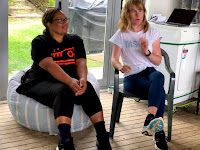Our final Design Thinking challenge for the weekend was to create a 'Crazy 8's poster'.
The purpose of this task was to come up with 8 ideas individually to solve our challenge. My ideas are as follows;
- Track trends
- Set up a maths knowledge programme for the senior school
- Create a game to gamify maths knowledge '
- Create a maths knowledge site
- Create a maths app
- Set up a maths team
- Student led workshops
- Mindset programme
Once we had come up with 8 ideas, we went around everyones 'Crazy 8's' and put a gold circle sticker on any of the ideas we liked. Once we had done this, we put one final 'special' sticker on the idea we liked the best.
It was really interesting and it surprised me with what ideas people liked. They differed to my own preference - but has made me think about how I can incorporate both sets of thinking for my final challenge design.











